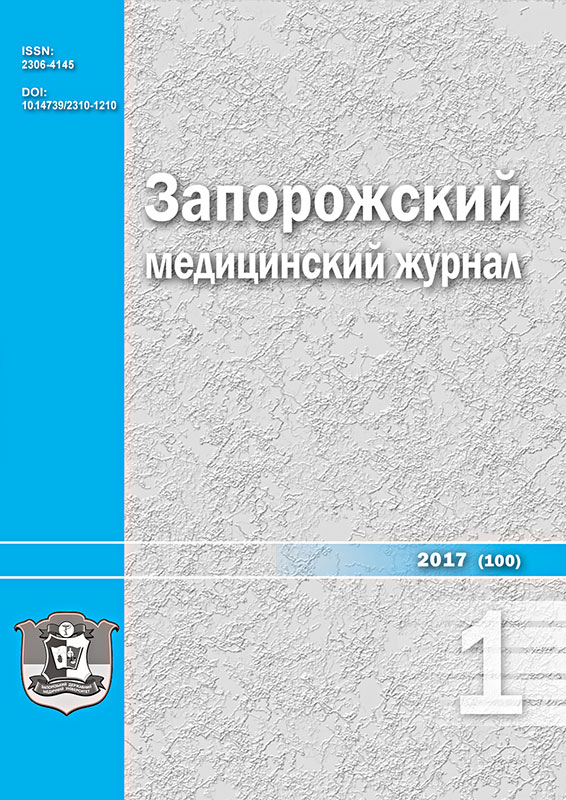Features of fetoplacental complex function in prolonged pregnancy
DOI:
https://doi.org/10.14739/2310-1210.2017.1.91636Keywords:
prolonged pregnancy, maternal-fetal, metabolism, progesterone, estriol, placental lactogen, cortisol, hydrocortisoneAbstract
The frequency of post-term pregnancy ranges from 3.5 to 16%. Compared to full-term newborns perinatal morbidity was in the post-term pregnancy group 1.7 times higher and mortality - in 5.5 times.
The aim. To study the features of feto-placental complex functioning in the post-term pregnancy; to detect relationship between complications of the gestational period and perinatal outcomes based on the feto-placental complex violations.
Materials and Methods. To study the features of delayed delivery and perinatal outcomes in this case 96 pregnant women with prolonged delivery were analyzed for 2013-2015, who gave birth in the term of 41-42 weeks. As a control group we examined 41 pregnant women, who did not differ from the comparison group by clinical and demographic characteristics, but with delivery in term of 37-40 weeks.
Results. In women with term pregnancy placental lactogen was 14.64 mg / ml and it was higher than the same indicator of post-term pregnancy (10.31 mg / ml). Reducing placental lactogen leads to a decrease in biosynthetic processes and growth retardation. In women of term pregnancy we found increased levels of estriol – 12.11 ng / ml at the end of gestational period, compared with prolonged pregnancy group (7.16 ng / ml), which corresponds to our concepts of the post-term pregnancy pathogenic features formation – lack of estriol level increasing before the start of delivery. The examination of the control group women showed a strong increase of progesterone – 158.79 ng / ml, while in the group of post-term pregnancy this index was almost 2 times less – 85.83 ng / ml. In women of term pregnancy group marked increase cortisol level before delivery was observed to 36.11 nmol / ml, more than the same indicator of post-term pregnancy (29.25 nmol / ml). Increased stress hormone cortisol indicates the hypothalamus-pituitary- adrenal cortex system activation for childbirth preparation.
Conclusions. There is a statistically significant decrease in hormones of the fetoplacental complex in prolonged pregnancy compared to the control group: cortisol - 19 % (р<0.05), placental lactogen – 30 % (р<0.05), estriol – 41 % (р<0.08) and progesterone - 46 % (р<0.05), which leads to the pathological hormonal background formation corresponding to prolonged pregnancy and is characterized by placental dysfunction in this category of pregnant women.
References
Stepancovskaya, G. K., &Gordeeva, G. D. (2010). Akusherstvo i ginekologiya [Obstetrics and gynecology]. Moscow: Eksmo-Press. [in Russian].
Caughey, A. B., Stotland, N. E., Washington, A. E., & Escobar, G. J. (2009). Who is at risk for prolonged and postterm pregnancy? Am J Obstet Gynecol, 200(6), 683. doi: 10.1016/j.ajog.2009.02.034.
Mittal, P., Romero, R., Tarca, A. L., Gonzalez, J., Draghici, S., Xu, Y., et al. (2010). Characterization of the myometrial transcriptome and biological pathways of spontaneous human labor at term. J. Perinat. Med, 38, 617–643. doi: 10.1515/JPM.2010.097.
Clark, S. L. & Fleischman, A. R. (2011). Term pregnancy: time for a redefinition. Clin Perinatal., 38(3), 557–564. doi: 10.1016/j.clp.2011.06.014.
Williams, P. J., Searle, R. F., Robson, S. C., Innes, B. A., & Bulmer, J. N. (2009). Decidual leucocyte populations in early to late gestation normal human pregnancy. J Reprod Immunol., 82(1), 24–31. doi: 10.1016/j.jri.2009.08.001.
Melamed, N., Ben-Haroush, A., Kremer, S., Hod, M., & Yogev, Y. (2010). Failure of cervical ripening with prostaglandin-E2 can it be predicted? J. Matern Fetal Neonatal Med., 23(6), 536–540. doi: 10.3109/14767050903197076.
Tripathi, V., Nara,S., Chaube, S. K., Rangari, K., Saroha, A., et al. (2008). Development of rapid and sensitive one-step direct enzyme linked immunosorbent assay for 17-alpha-OH-progesterone inserum. J. Immuno assay Immunochem, 29(2), 117–127. doi: 10.1080/15321810801887599.
Downloads
How to Cite
Issue
Section
License
Authors who publish with this journal agree to the following terms:
Authors retain copyright and grant the journal right of first publication with the work simultaneously licensed under a Creative Commons Attribution License that allows others to share the work with an acknowledgement of the work's authorship and initial publication in this journal. 

